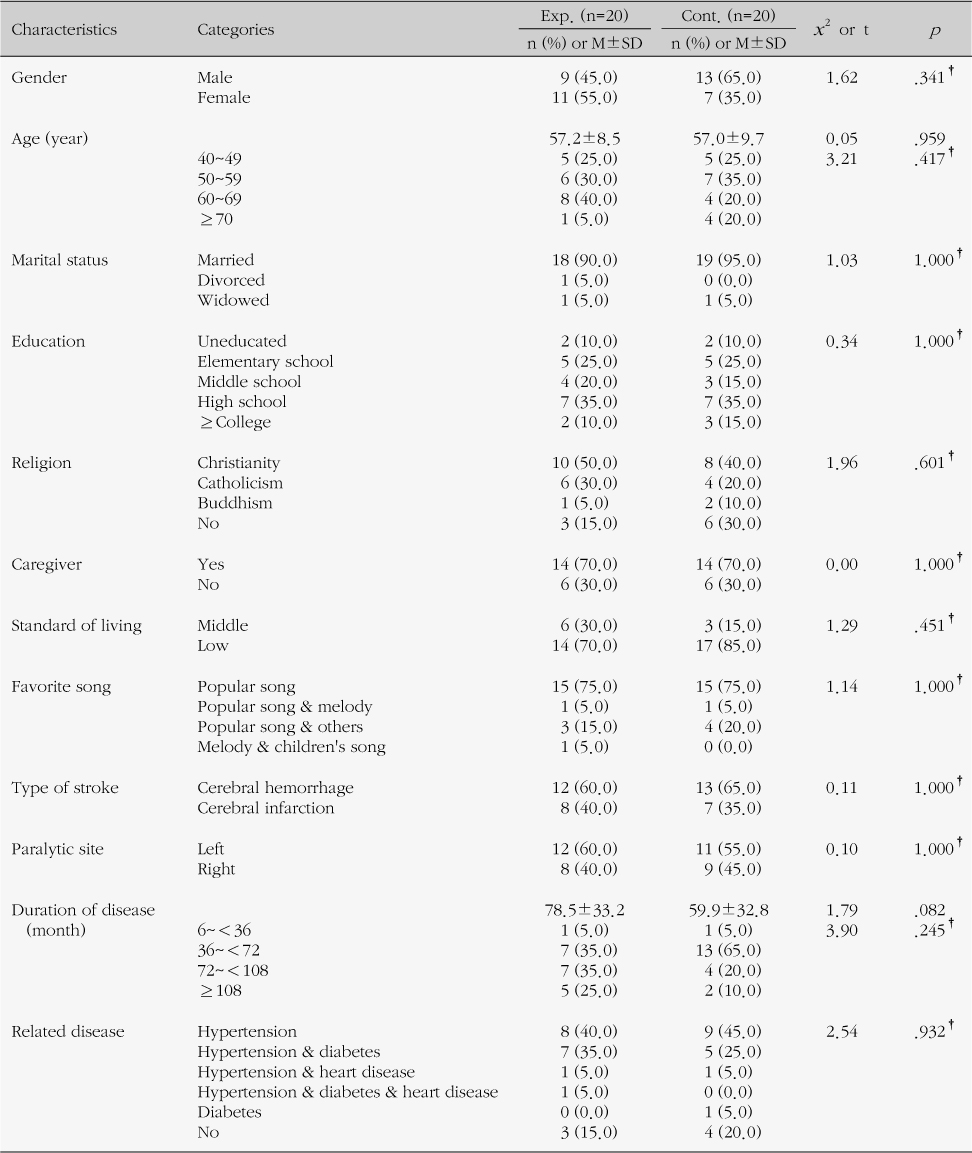References
1. Burvill PW, Johnson GA, Jamrozik KD, Anderson CS, Stewart-Wynne EG, Chakera TM. Prevalence of depression after stroke: The Perth community stroke study. Br J Psychiatry 1995;166(3):320–327.
2. Choi BC. Music therapy Seoul: Hakjisa; 2005.
3. Choi EJ. Effects of rehabilitation program based on self-efficacy on poststroke patients Seoul: Seoul National University; 2002. Unpublished doctoral dissertation.
4. Chon KK, Choi SC, Yang BC. Integrated adaptation of CES-D in Korea. Korean J Health Psychol 2001;6(1):59–76.
5. Chun SK. A study on the effectiveness of social skills training program for rehabilitation of the schizophrenic patients Seoul: Soongsil University; 1995. Unpublished doctoral dissertation.
6. Cohen J. Statistical power analysis for the behavioral sciences 2nd edth ed. Hillsdale: Lawrence Erlbaum Associates, Inc; 1988.
7. Cross P, McLellan M, Vomberg E, Monga M, Monga TN. Observations on the use of music in rehabilitation of stroke patients. Physiother Can 1984;36:197–201.
8. Feys HM, De Weerdt WJ, Seiz BE, Cox Steck GA, Spichiger R, Wereeck LE, et al. Effect of a therapeutic intervention for the hemiplegic upper limb in the acute phase after stroke. Stroke 1998;29:785–792.
9. Hanser SB, Thomson LW. Effects of a music therapy strategy on depressed older adults. J Gerontol 1994;49(6):P265–P269.
10. Hesse S, Schauer M, Malezic M, Jahnke MT. Quantitative analysis of rising from a chair in healthy and hemiparetic subjects. Scand J Rehabil Med 1994;26:161–166.
11. Janet HC, Roberta BS. Stroke rehabilitation: Guidelines for exercise and training to optimize motor skill Oxford: Elsevier Publishing Company; 2003.
12. Jeong SH. Effects of music-movement program for stroke survivors Seoul: Seoul National University; 2003. Unpublished doctoral dissertation.
13. Kang JY. Effects of constraint-induced movement using self-efficacy on the upper extremity function of hemiplegic patients Seoul: Seoul National University; 2002. Unpublished doctoral dissertation.
14. Kim JC, Kim MJ, Park SB, Lee SG, Jang SJ. Jebsen hand function test in rheumatoid arthritis patients. J Korean Acad Rehabil Med 1999;23(2):405–410.
15. Kim K, Seo H, Kim E. Effects of 5 weeks self-help management program on reducing depression and promoting activity of daily livings, grasping power, hope and self-efficacy. Korean J Rehabil Nurs 2000;3(2):196–211.
16. Kim MY. A study of manual functional test for C.V.A. J Korean Acad Occup Ther 1994;2:19–26.
18. Lee HD. Practice of interpersonal relationship training Seoul: Jungangjeoksung Publishing; 1992.
19. Mosby's medical, nursing & allied health dictionary 6th edth ed. Seoul: Hyunmoosa; 2002.
20. Nakamura R, Moriyama S. Manual function test (MFT) and functional occupational therapy for stroke patients Tokorozawa: National Rehabilitation Center for the Disabled; 1987.
21. Nayak S, Wheeler B, Shiflett S, Agostinelli S. Effect of music therapy on mood and social interaction among individuals with acute traumatic brain injury and stroke. Rehabil Psychol 2000;45(3):274–283.
22. Radloff LS. The CED-D scale: A self-report depression scale for research in the general population. Appl Psychol Meas 1977;1:385–401.
23. Morris PL, Raphael B, Robinson RG. Clinical depression is associated with impaired recovery from stroke. Med J Aust 1992;157(4):239–242.
24. Schaechter JD, Kraft E, Hilliard TS, Dijkhuizen RM, Benner T, Finklestein SP, et al. Motor recovery and cortical reorganization after constraint-induced movement therapy in stroke patients: Apreminary study. Neurorehabil Neural Repair 2002;16:326–338.
25. Schlein S, Guerney B, Stover L. The interpersonal relationship scale University Park: Pennsylvania State University; 1971. Unpublished doctoral dissertation.
27. Thaut MH. Training manual for neurologic music therapy Fort Collins, CO: Center for Biomedical Research in Music; 1999.
28. Thaut MH, Kenyon GP, Schauer ML, McIntosh GC. The connection between rhythmicity and brain function. IEEE Eng Med Biol Mag 1999;18(2):101–108.
29. Tong KY, Mak AF. Development of computer-based environment for stimulating the voluntary upperlimb movements of persons with disability. Med Biol Eng Comput 2001;39:414–421.
30. Yalom I, Vinogradov S. Self-disclosure in group therapy. In : Stricker G, Fisher M, eds. Self-disclosure in the therapeutic relationship New York: Plenum Press; 1990.


